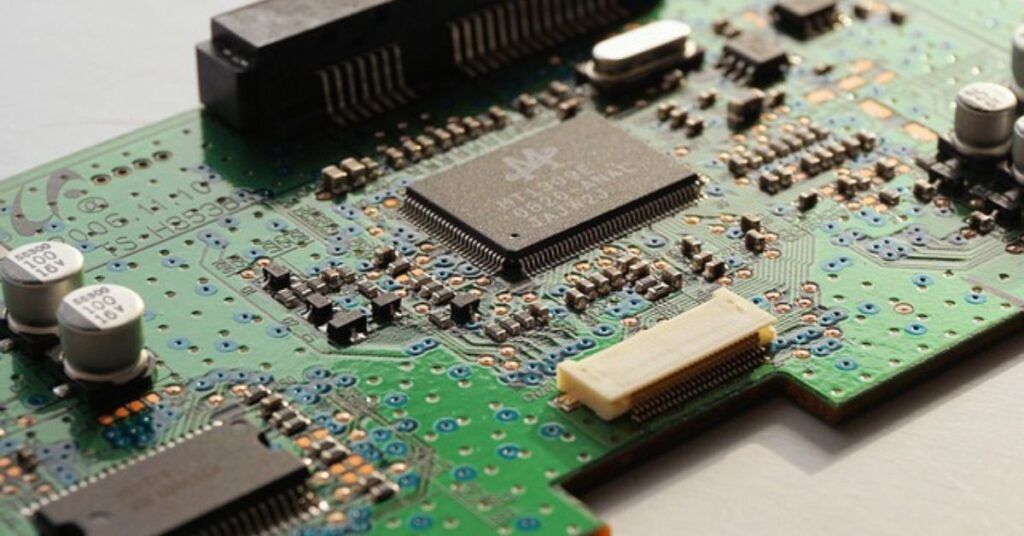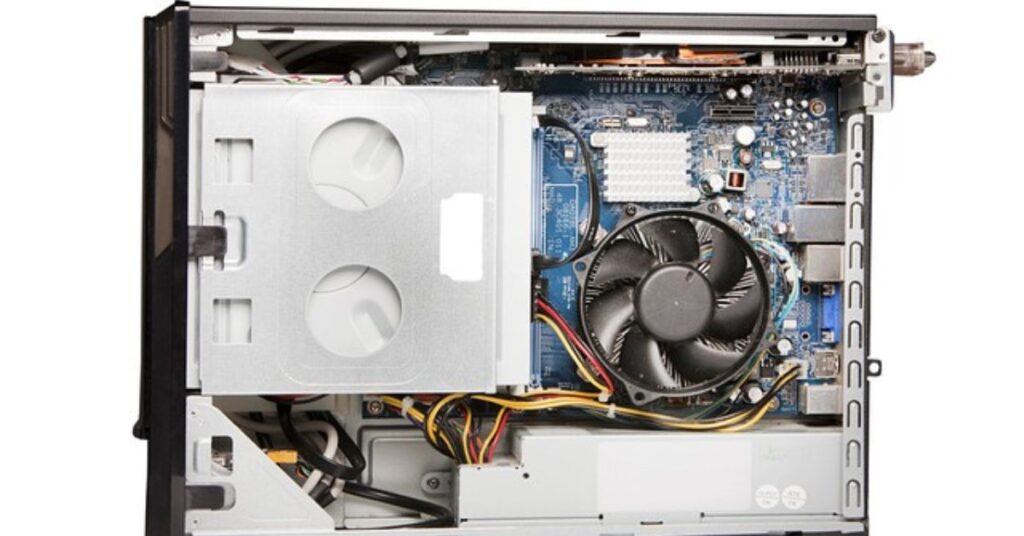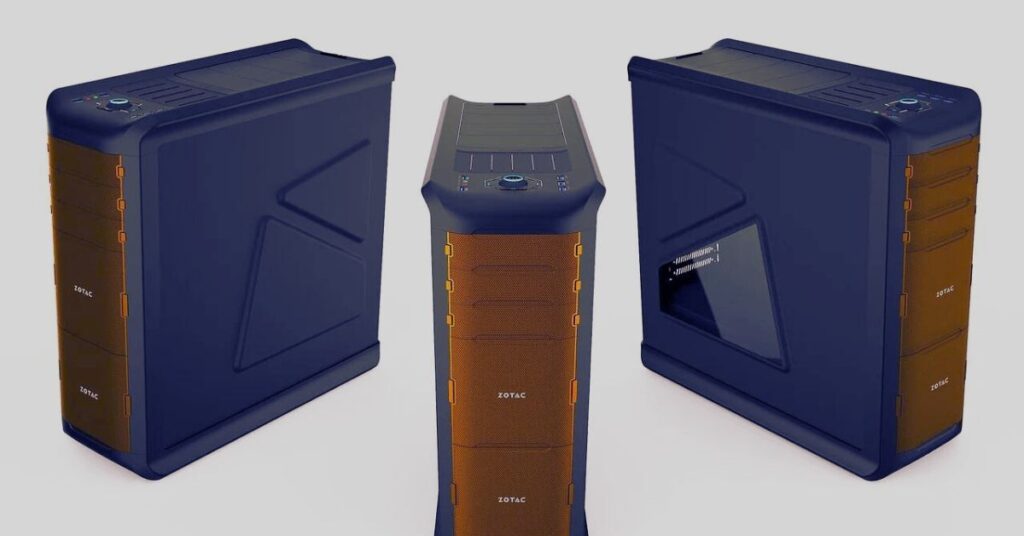Have you ever wondered Where the motherboard is located in a computer? The motherboard is the central nervous system of your computer, connecting and powering all the essential components. It serves as the home for the CPU, RAM, and other vital hardware. Despite its importance, many people are unsure of its exact placement within their computer.
Table of Contents
Understanding the Motherboard and their role

Before we pinpoint the motherboard’s location, let’s grasp its significance within the intricate framework of a computer. Think of the motherboard as the central nervous system of your machine, orchestrating the flow of data and power to every component.
Fundamentally, the motherboard acts as a gathering place for several important hardware parts to interact with one another. It offers the vital channels and connectors needed for the smooth operation of your CPU, RAM, storage devices, graphics card, and other accessories. Your computer would essentially be a collection of uncoordinated parts without any means of coordination if it weren’t for the motherboard.
In short, the motherboard serves as the framework for your computer system. It is a crucial component in determining the overall functionality and efficiency of your machine because of the way it is designed and laid out, which affects the performance and compatibility of other parts.
Further reading: Where Is The Motherboard Serial Number?
Location Within the Computer Case

So, where exactly does the motherboard reside within the confines of your computer case? Picture your computer case as a sturdy housing, designed to contain and protect its internal components. The motherboard typically finds its place nestled snugly inside this enclosure.
As you peer into the depths of your computer case, you’ll likely spot the motherboard positioned either horizontally at the bottom or mounted vertically along one of the side panels. Its placement may vary depending on the case design and form factor.
In most traditional tower-style cases, motherboard is often situated horizontally at the bottom. This placement allows for easy access to the CPU socket, expansion slots, and connectors. It also facilitates efficient airflow management, with components like the CPU cooler and system fans directing airflow across the motherboard’s surface to aid in cooling.
However, in some compact or specialized cases, you might encounter motherboards mounted vertically along one of the side panels. This configuration optimizes space utilization and may be preferred in scenarios where a smaller footprint is desirable.
Further reading: How to connect case fans to motherboard?
Importance of the Motherboard’s Location

Understanding where the motherboard is located within your computer case is more than just a matter of spatial awareness; it’s a fundamental aspect of computer hardware literacy with practical implications.
Here’s why the motherboard’s location holds significance:
Component Connectivity
The motherboard serves as the primary interface for connecting essential components such as the CPU, RAM, storage drives, and expansion cards. Knowing its location helps in identifying and accessing these components for installation, upgrades, or troubleshooting.
Heat Dissipation
Efficient cooling is crucial for maintaining optimal performance and prolonging the lifespan of computer components. The motherboard’s location influences airflow patterns within the case, affecting the cooling of critical components like the CPU and chipset. Understanding its position allows for strategic placement of cooling solutions such as fans or liquid cooling systems.
Expansion Possibilities
Expansion slots on motherboards allow you to add additional components to your system, like dedicated sound, graphics, or network adapters. Knowing where the motherboard is located makes it easier to find open expansion slots and assess whether expansion cards will work with it.
Cable Management
Proper cable management is essential for maintaining a tidy and organized interior of your computer case. The motherboard’s location dictates the routing of cables for power supply, data transfer, and peripheral connections. Knowing where it’s situated enables efficient cable routing, minimizing clutter and optimizing airflow.
Further reading: Why motherboard is green?
Practical Considerations
Knowing where the motherboard is located within your computer case translates into several practical benefits and applications in the realm of computer hardware.
- DIY Computer Building: If you’re assembling your computer system, understanding the motherboard’s location is crucial. It serves as the foundation upon which you’ll install the CPU, RAM, storage drives, and other essential components. By knowing its position, you can ensure proper alignment and installation of these components, setting the stage for a successful build.
- Component Upgrades: Whether you’re upgrading your CPU, adding more RAM, or installing a new graphics card, familiarity with the motherboard’s location simplifies the upgrade process. You’ll know exactly where to access the relevant components and expansion slots, making the upgrade procedure smoother and more efficient.
- Maintenance: Routine maintenance tasks, such as cleaning dust buildup or replacing CMOS batteries, are simplified when you know the motherboard’s location. You can easily access the motherboard and its associated components, ensuring that your system remains in optimal working condition.
- Troubleshooting: In the event of hardware issues or performance problems, understanding the motherboard’s location aids in troubleshooting. You can easily access critical components such as the RAM modules or CPU sockets for inspection, reseating, or replacement.
Conclusion
The motherboard serves as the central hub of a computer system, orchestrating the interactions between critical hardware components. Understanding its location within the computer case is essential for a myriad of practical reasons, ranging from DIY computer building to troubleshooting and maintenance.
Understanding the motherboard’s primary function and physical location will help you better understand your computer’s internal operations. With this information, you can build, upgrade, or maintain your system with confidence, increasing its longevity, performance, and dependability in the process.
Therefore, keep in mind how crucial it is to understand the location of the motherboard whether you’re building a computer yourself, troubleshooting hardware, or just trying to maximize cable management. With this knowledge, you’ll be able to confidently and skillfully navigate the world of computer hardware and unleash the full potential of your digital powerhouse.
FAQ: Where the Motherboard is Located in a Computer?
Where is the motherboard located in a computer?
The motherboard is typically located inside the computer case, positioned either horizontally at the bottom or mounted vertically along one of the side panels.
How can I identify the motherboard’s location on my computer?
You can identify the motherboard’s location by opening the computer case and locating the large, flat circuit board to which various components are attached. It is often positioned in a central or easily accessible area within the case.
Can the motherboard’s location vary depending on the computer case?
Yes, the motherboard’s location can vary depending on the design and form factor of the computer case. In traditional tower-style cases, it is usually located horizontally at the bottom, while in compact or specialized cases, it may be mounted vertically along a side panel.
Are there specific tools or resources available to help locate the motherboard in a computer?
While there are no specific tools required, consulting the computer’s user manual or online resources for your specific motherboard model can provide detailed information about its location and layout within the case. Additionally, observing the internal layout of the computer case can help identify the motherboard’s position.
